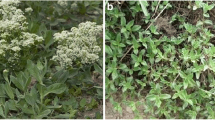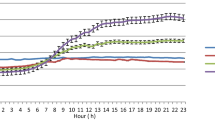Abstract
This study evaluated the activity of plant extracts on Nosema ceranae development and their toxicity on the infected host Apis mellifera. Newly emerged bees were fed ad libitum with enriched syrups after individual infection. Diets consisted of ethanolic extracts obtained from Artemisia absinthium, Allium sativum, Laurus nobilis, and Ilex paraguariensis diluted in syrup at 1% and 10% concentrations. Examination of individual midgut homogenates on day 19 post-infection indicated that 1% concentration of L. nobilis extract significantly inhibited N. ceranae development. Absinth extract, previously reported as effective against Nosema apis, did not diminish the number of N. ceranae spores throughout the experiment. Ten percent concentrations showed high toxicity on infected bees, but also a significant activity diminishing parasitosis development in short periods. Syrups with the addition of extracts were consumed avidly as the control, even more in some cases. The present study constitutes the first report of antiparasitic activity in vivo of plant extracts against the Microsporidian N. ceranae and postulate natural substances as an alternative for antiparasitic treatment.


Similar content being viewed by others
References
Adamczyk, S., Lázaro, R., Pérez-Arquillué, C., Conchello, P., Herrera, A. (2005) Evaluation of residues of essential oil components in honey after different anti-Varroa treatments. J Agric Food Chem. 53,10085–10090. doi:10.1021/jf051813f
Adler, L.S. (2000) The ecological significance of toxic nectar. Oikos 91, 409–420
Ahameethunisa, A.R., Hopper, W. (2010) Antibacterial activity of Artemisia nilagirica leaf extracts against clinical and phytopathogenic bacteria. BMC Comp Altern Med 10, 6. http://www.biomedcentral.com/1472-6882/10/6
Ankri, S., Mirelman, D. (1999) Antimicrobial properties of allicin from garlic. Microbes Infect 2(2), 125–9 doi:10.1016/S1286-4579(99)80003-3
Ankri, S., Miron, T., Rabinkov, A., Wilchek, M., Mirelman, D. (1997) Allicin from garlic strongly inhibits cysteine proteinases and cytopathic effects of Entamoeba histolytica. Antimicrob. Agents Chemother. 10, 2286–2288
Berbehenn, R.V., Martin, M.M. (1994) Tannin sensitivity in larvae of Malacosoma disstria (Lepidoptera): roles of the pertitrophic envelope and midgut oxidation. J. Chem. Ecol. 20, 1985–2001
Block, E. (1992) The organosulfur chemistry of the genus Allium -Implication for the organic chemistry of sulfur. Angew. Chem. Int. 31, 1135–1178
Cantwell, G.E. (1970) Standard methods for counting nosema spores. Am. Bee Jj. 110, 220–223
Costa, C., Lodesani, M., Maistrello, L. (2010) Effect of thymol and resveratrol administered with candy or syrup on the development of Nosema ceranae and on the longevity of honeybees (Apis mellifera L.) in laboratory conditions. Apidologie 41, 141–150
Damiani, N. (2010) Control del parásito Varroa destructor (Acari: Varroidae) en colmenas de Apis mellifera (Hymenoptera: Apidae). Doctoral thesis. School of Exact and Naturals Science. National University of Mar del Plata. Argentina (in Spanish)
Ertürk, O. (2006) Antibacterial and antifungal activity of ethanolic extracts from eleven spice plants. Sect. Cell. Mol. Biol. 61, 275–278
Fries, I. (2010) Nosema ceranae in European honey bees (Apis mellifera). J Invertebr. Pathol. 103, 73–79
Gende, L.B. (2009) Principales componentes de aceites esenciales relacionados con actividad antimicrobiana frente a Paenibacillus larvae. Doctoral thesis. School of Pharmacy and Biochemistry. University of Buenos Aires. Argentina (in Spanish).
Gende, L.B., Principal, J., Maggi, M.D., Palacios, S.M., Fritz, R., Eguaras, M.J. (2008) Extracto de Melia azedarach y aceites esenciales de Cinnamomun zeylanicum, Mentha piperita y Lavandula officinalis como control de Paenibacillus larvae. Zoot. Trop. 26, 151–156
He, X.G. (2000) On-line identification of phytochemical constituents in botanical extracts by combined high-performance liquid chromatographic–diode array detection–mass spectrometric techniques. J. Chromatogr. 880, 203–232
Higes, M., García-palencia, P., Martín-Hernández, R., Meana, A. (2007) Experimental infection of Apis mellifera with Nosema ceranae (Microsporidia). J. Invertebr. Pathol. 94, 211–217
Keeling, P.J., Fast, N.M. (2002) Microsporidia: Biology and evolution of highly reduced intracellular parasites. Annu. Rev. Microbiol. 56, 93–116
Lawson, L.D. (1993) Bioactive organosulfur compound of garlic and garlic products: role in reducing blood lipids. In: Kinghorn, A.D., Balandrin, M.F. (eds.) Human medicinal agents from plants, pp. 306–330. American Chemical Society, Washington
Lawson, L.D., Block, E. (1997) Comments on garlic chemistry stability of s-(2-propenyl) 2 propene-1- sulfinothioate (allicin) in blood solvents and stimulated physiological fluids. J. Agric. Food. Chem. 45, 542
Leiro, J., Cano, E., Ubeira, F.M., Orallo, F., Sanmartìn, M.L. (2004) In vitro effects of resveratrol on the viability and infectivity of the Microsporidian Encephalitozoon cuniculi. Antimicrob. Agents Ch. 48, 2497–2501
Maistrello, L., Lodesani, M., Costa, C., Leonardi, F., Marani, G., Caldon, M., Mutinelli, F., Granato, A. (2008) Screening of natural compounds for the control of nosema disease in honey bees (Apis mellifera). Apidologie 39, 436–444
Martín-Hernández, R., Meana, A., Prieto, L., Martínez, S.A., Garrido-Bailón, E., Higes, M. (2007) Outcome of Colonization of Apis mellifera by Nosema ceranae. Appl. Environ. Microbiol. 73, 6331–6338
Mayack, C., Naug, D. (2009) Energetic stress in the honey bee Apis mellifera from Nosema ceranae infection. J. Invertebr. Pathol. 100(3), 185–188
Mirelman, D., Monheit, D., Varon, S. (1987) Inhibition of growth of Entamoeba histolytica by Allicin, the active principle of garlic extract (Allium sativum). J. Infect. Dis. 156, 243–244
Nanasombat, S., Lohasupthawee, P. (2005) Antibacterial activity of crude ethanolic extracts and essential oils of spices against salmonellae and other enterobacteria. Sci. Tech. J. 5, 462–469
Nejad, B.S., Deokule, S.S. (2009) Anti-dermatophytic activity of Drynaria quercifolia (L.). Jundishapur. J. Microbiol. 2, 25–30
Ong, E.S. (2004) Extraction methods and chemical standardization of botanicals and herbal preparations. J. Chromatogr. 812, 23–33
Paxton, R.J., Klee, J., Korpelab, S., Fries, I. (2007) Nosema ceranae has infected Apis mellifera in Europe since at least 1998 and may be more virulent than Nosema apis. Apidologie 38, 558–565
Pohorecka, K. (2004a) Effect of standardized plant herb extracts on general condition of the honeybee (Apis mellifera l.). Bull. Vet. Inst. Pulawy. 48, 415–419
Pohorecka, K. (2004b) Laboratory studies on the effect of standardized Artemisia absinthium L. extract on Nosema apis infection in the worker Apis mellifera. J. Apic. Sci. 48, 131–136
Porrini, M.P., Audisio, M.C., Sabaté, D.C., Ibarguren, C., Medici, S.K., Sarlo, E.G., Garrido, P.M., Eguaras, M.J. (2010) Effect of bacterial metabolites on microsporidian Nosema ceranae and on its host Apis mellifera. Parasitol. Res. 107, 381–388
Porrini, M.P., Sarlo, E.G., Medici, S.K., Garrido, P.M., Porrini, D.P., Eguaras, M.J. (2011) Nosema ceranae development in Apis mellifera: Influence of diet and infective inoculum. J. Apic. Res. 50(1), 35–41
Rinderer, T.E. (1976) Honey bees: individual feeding of large numbers of adult workers. J. Econ. Entomol. 69, 489–491
Rodríguez Vaquero, M.J., Tomassini Serravalle, L.R., Manca de Nadra, M.C., Strasser de Saad, A.M. (2009) Antioxidant capacity and antibacterial activity of phenolic compounds from argentinean herbs infusions. Food Control. 21, 799–785
Soylu, E.M., Tok, F.M., Soylu, S., Kaya, A.D., Evrendilek, G.A. (2005) Antifungal activities of essential oils on post harvest disease agent Penicillium digitatum. Pak. J. Biol. Sci. 8, 25–29
Tariq, K.A., Chishti, M.Z., Ahmada, F., Shawl, A.S. (2009) Anthelmintic activity of extracts of Artemisia absinthium against ovine nematodes. Vet. Parasitol. 160, 83–88
Williams, G.R., Sampson, M.A., Shutler, D., Rogers, R. (2008) Does fumagillin control the recently detected invasive parasite Nosema ceranae in western honey bees (Apis mellifera)? J. Invertebr. Pathol. 99, 342–344
Yoshida, M., Fuchigami, M., Nagao, T., Okabe, H., Matsunaga, K., Takata, J., Karube, Y., Tsuchihashi, R., Kinjo, J., Mihashi, K., Fujioka, T. (2005) Antiproliferative constituents from Umbelliferae plants VII. Active triterpenes and rosmarinic acid from Centella asiatica. Biol. Pharmacol. Bull. 28, 173–175
Acknowledgments
The authors wish to thank CONICET, UNMdP. This research was supported by ANPCyT (FONCyT), project PICT 890/06, to M.E. We thank the support provided by the 426 Animal Production Department, EEA INTA, Balcarce, the Fares Taie Laboratories Food Division and the contribution made by Enrique Tkacik.
Evaluation in vivo de l'activité anti-parasitaire d'extraits de plantes sur Nosema ceranae (Microsporidia)
Apis mellifera / Nosema ceranae / extrait de plante / traitement anti-parasitaire
Eine in vivo Methode zur Beurteilung der antiparasitischen Wirkung von Pflanzenextrakten gegen Nosema ceranae (Microsporidia)
Apis mellifera / Nosema ceranae / Pflanzenextrakt / antiparasitische Behandlung
Author information
Authors and Affiliations
Corresponding author
Additional information
Manuscript editor: David Tarpy
Rights and permissions
About this article
Cite this article
Porrini, M.P., Fernández, N.J., Garrido, P.M. et al. In vivo evaluation of antiparasitic activity of plant extracts on Nosema ceranae (Microsporidia). Apidologie 42, 700–707 (2011). https://doi.org/10.1007/s13592-011-0076-y
Received:
Revised:
Accepted:
Published:
Issue Date:
DOI: https://doi.org/10.1007/s13592-011-0076-y




